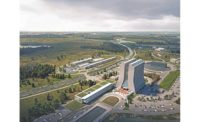 |
The risk, time and stress associated with obtaining approval for a performance-based skyscraper design in highly seismic California is diminishing, even compared to a year ago. The long-suffering protagonists for “extreme” seismic engineering of tall buildings are nearly jumping for joy. And it’s not only because performance-based highrises 240 ft and taller can cost less and take less time to build than those designed to prescriptive code provisions. It’s because the performance design approach, which relies heavily on peer review, can result in higher-quality highrises.
“The biggest impact of all this, from a 40,000-ft level, is significantly improved tall buildings in seismic zones,” says Ron Klemencic, president of structural engineer Magnusson Klemencic Associates (MKA), Seattle.
“Some think performance design is a way to cheat the code and cheapen the building,” says Klemencic, who is acknowledged as a pathfinder in this area. “But it is the opposite because of the thoroughness and rigor of the engineering required,” he explains.
For a skyscraper 240 ft or taller in a high seismic zone—from Seattle to San Diego—a performance design (PD), which provides a building that meets the intent of the prescriptive code requirements, can result in a job that costs $5 to $7 per sq ft less. Much of the savings comes from avoiding a dual lateral-force-resisting system, required under the prescriptive code. A single lateral system, such as a ductile concrete core wall system, not only costs less, it frees the perimeter of a heavy moment frame and eliminates field-welding.
|
For the owner and the design team, the only—but potentially serious—drawback of a ‘performance’ skyscraper is the risk of delay in the plan approval and permitting process. The design engineer must convince the buildings department, understandably reluctant to approve something untried with so much at stake, that the design meets the intent of the code’s prescriptive requirements. For this, peer review is a must.
That is the wild card. Peer review can result in an improved design. But the process, which is supposed to be conducted in an objective way, also can degrade into a dispute between the reviewer and the design engineer. And that can throw a wrench in the works.
In conservative San Francisco, developers have been reluctant to go through the wringer of PD peer review. For the 645-ft-tall 301 Mission, on deck to be the West Coast’s tallest concrete frame, “the client felt it more important to manage a review process we had used before rather than face the unknown,” says Stephen V. DeSimone, president of DeSimone Consulting Engineers, New York City.
 |
| Torsion. Performance design simulates a tower’s seismic responses. (Image courteswy of Magnusson Klemencic Associates) |
That attitude is starting to disappear, thanks to the efforts of MKA, which recently received approval for two, innovative PDs. One took five years, on and off. The other took 1.5 years. The typical approval period is about six months.
“It was a nail-biter, but MKA’s approval will open the floodgate in San Francisco and elsewhere in California,” says DeSimone. Based on MKA’s coups, DeSimone is going the PD route on two upcoming towers, one in San Francisco and the other in nearby Oakland.
The strenuous MKA approval sagas and the prospect of a flurry of upcoming tall building projects inspired San Francisco building officials to write guidelines for the structural review of new tall buildings, says Hanson Tom, principal engineer in San Francisco’s Dept. of Building & Inspection. “We are trying to set up a criteria for review,” says Tom. He says he is “very encouraged” by the movement forward regarding PD approvals.
The San Francisco bulletin is necessary because the city’s code is a one-size-fits-all document geared to lower-rise buildings, says Tom. The bulletin will require peer review for all buildings 240 ft and taller, even those that follow prescriptive code requirements. The result will be an improved plan review, permitting and inspection process for all tall buildings, and higher-quality highrises, says Tom.
The city expects to issue the guidelines in June as an administrative bulletin. Tom expects the guide also will help speed approvals. Klemencic still thinks that it could take six months to 1.5 years to get approval for PDs. By contrast, approval has taken as little as five months in Seattle, where MKA has done a half-dozen PD skyscrapers .
The San Francisco document is based on the Los Angeles Tall Buildings Structural Design Council’s guideline for seismic PD, published in January. Sources say the L.A. guideline was indirectly inspired by the San Francisco-MKA approvals nightmare, which grabbed attention all along the West Coast.
“We view the two documents as steps in the right direction,” says Klemencic. “They indicate that performance design is becoming more mainstream and gaining wider acceptance on the part of building officials.”
With the progress in San Francisco, Klemencic sees even broader acceptance ahead for PD in reluctant cities, such as Sacramento and San Diego. He also sees the prospect of “700, 800, 900 or even 1,000-ft buildings” in seismic zones, thanks to the economies of PD.

